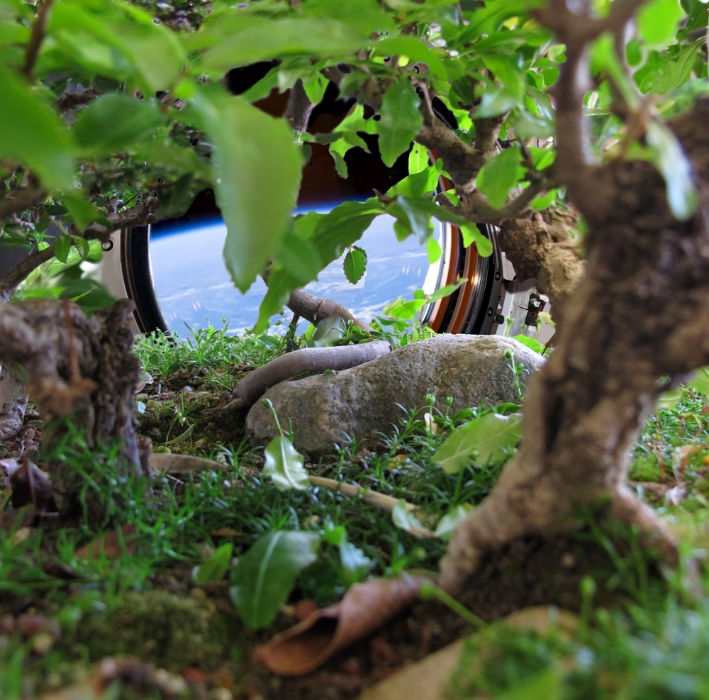I encounter digital images of the Bikernieki Forest in Latvia. They have been shared with countless other people by someone on a Flickr account. It is the beginning of fall, the leaves are yellowing outside Riga. I do not know this place, but I have heard of it. History washes over me, a flood of light from my computer screen. She loved perfume. She was my great-aunt. I was robbed, never able to know her.
Is her body here?
“When, in a wood we come upon a mound, six foot long, three foot wide, heaped up into a pyramid with a spade, then we become serious and something inside us says: someone lies buried here. That is architecture.” (Adolf Loos, “Architektur”)
Facing Murder, Matter (2010), Mixed media installation with fragrance
I walk through the images, encountering the cement borders, the mossy stone, the white travertine or marble paths guiding my eye through the forest, to the mass grave. Each stone a memorial to a village. How can so many people be here with me? Madly I start to draw this space. I pace it out. I make a model. I inhabit the model with my eyes.
Facing Murder, Matter is an experiential sculpture and memory-well where trauma and ethics meet in an architectural/philosophical grid. It is the outgrowth of a long project: the English translation and publication of Claire Beck Loos’ biography Adolf Loos Privat, for which I was the editor. The installation incorporates some of the signature perfume notes from the era about which she writes - before the war - when Loos and Claire frequented the European café’s, the south of France, and a Bohemian Parisian art scene: the carnation/patchouli accord of “Tabu”; the sticky rose note of “Shocking” by Schiaparelli; Guerlain’s elegiac and tempestuous “Vol de Nuit”; the woody violet and jasmine of “Je Reviens”. I will return.
She loved perfume. It is one of the few personal details about her I know, from a relative who knew her as a teenager. Would she have worn “Vol de Nuit” (1933), heavy with galbanum? I know the notes in this scent: Peru balsam, musk, vetiver, sandalwood, benzoin, orris root. I imbue my model with Flight of Night, and the forest – it opens up again.
Adolf Loos and Claire Beck Loos, circa 1930. Courtesy Burkhardt Rukschcio.
Claire's book helped fund a monument at Loos' first gravesite after he died in 1933. The grave was to his specifications, but had been drawn out by her, his secretary, proxy, lover, translator. Thirty-five years her senior he was ill even before their wedding, a man descending into silence, going deaf. How ever did she love him? This brilliant, tyrannical man, a life force to be reckoned with? Did she take that resilience with her, all the way to that dreadful place?
I read Claire’s book. I feel the joy of the words. I hear her voice, her spare and elegant language. Her humor. She sang to Loos – Schönberg’s Gurrelieder – loudly into his ear horn. I hear the voice of the architect asking her to sing it again, to sing it all day.
Weeping scent stones in Facing Murder, Matter
Let us focus not only on this time and place, but the state of people and nations after empires collapse. There are mirrors everywhere in today’s events, and from my perspective they can be read as echoes of each other and specifically the fall of Austro-Hungary. Viennese culture at the turn of the last century was highly influential on European culture and – one might argue by extension, considering the influence of Western colonialism – the world. The assassination of Crown Prince Rudolf set off wars lasting now almost one hundred years.
But did this modernism, which Loos espoused not only for architecture but also the cleansing of social ills (and I use this word carefully, in all its breadth and context), have the potential to become an architecture of integration? What possible self-reform was it proposing? And specifically, how was this reform truncated by Vienna’s Civil War, the Second World War, and the dispossession and genocide of Austro-Hungarian and Czech Jews?
There is much more to be said about how the struggle for liberation from colonialism differs from the violence of dispossession of the integrated, assimilated subject.
The stories of both Loos’ and Claire’s deaths need to be taken together now to heal a much larger, lasting, social rift. They might give a glimpse as to modernism’s legacy, its forgotten promises, failings, and its covenant.
Facing Murder, Matter, detail (2010)
Adolf Loos – A Private Portrait by Claire Beck Loos (DoppelHouse Press 2011)





